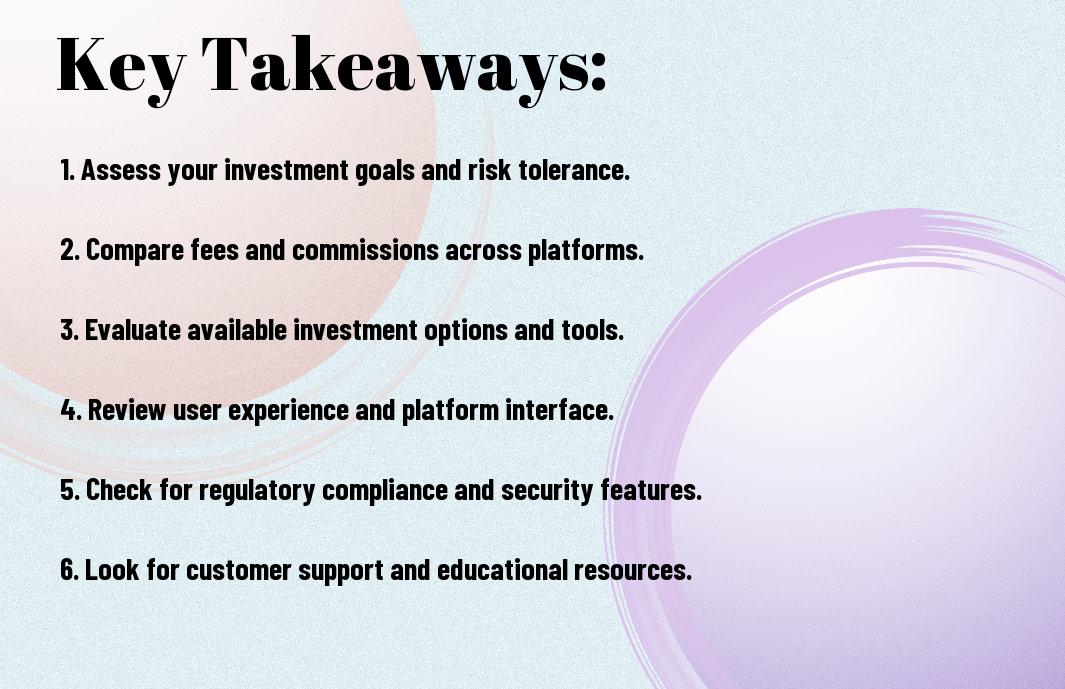Just as you wouldn’t jump into a pool without checking the water first, choosing the right stocks for your portfolio requires careful consideration and research. In this guide, you will explore key strategies and tips that can help you make informed investment decisions, tailor your portfolio to match your financial goals, and navigate the complexities of the stock market with confidence. By understanding your risk tolerance, market trends, and company fundamentals, you can build a diverse and effective portfolio that aligns with your investment aspirations.
Key Takeaways:
- Understand Your Goals: Define your investment objectives and risk tolerance before selecting stocks.
- Research Companies: Analyze financial health, management effectiveness, and industry position of potential stocks.
- Diversification: Spread investments across various sectors to reduce risk and enhance portfolio stability.
- Evaluate Valuation Metrics: Use tools like P/E ratio, dividend yield, and debt-to-equity ratio to assess stock value.
- Stay Informed: Keep up with market news and trends to make informed decisions about your investments.


Understanding Your Investment Goals
As you examine into stock selection, it’s crucial to clarify your investment goals. Knowing what you want to achieve with your portfolio will guide your decisions and help you identify the most suitable stocks. Are you aiming for long-term growth, short-term gains, or maybe a mix of both? By understanding your objectives, you can tailor your stock choices to align with your overall financial strategy.
Risk Tolerance
To effectively choose the right stocks, you must assess your risk tolerance. This involves determining how much volatility you can handle without affecting your peace of mind. Understanding whether you are comfortable with high-risk investments that have the potential for greater returns or prefer a more conservative approach will shape your stock selection process.
Time Horizon
Behind every investment decision lies your time horizon, an crucial factor in shaping your portfolio. This refers to the length of time you expect to hold your investments before needing access to your money. By understanding your time frame, you can implement a strategy that aligns with your financial goals, balancing growth potential against the associated risks.
Your time horizon significantly influences your investment choices. If you’re looking to invest for a short term, you may prefer lower-risk stocks with more stable returns. Conversely, a longer time horizon allows you to absorb market fluctuations, opening up opportunities for higher-risk investments that may yield greater rewards. Knowing when you will need your money helps you craft a well-balanced portfolio that meets your needs and goals.
Analyzing Company Fundamentals
Some of the key elements to consider when analyzing company fundamentals include financial health, competitive edge, and market conditions. By understanding these factors, you can make informed decisions about which stocks to select for your portfolio. This insight helps you gauge a company’s potential for growth and stability.
Financial Statements
Analyzing financial statements, such as the balance sheet, income statement, and cash flow statement, provides you with a comprehensive view of a company’s performance. These documents reveal critical information about its revenue, expenses, and profitability, helping you assess whether the company is a sound investment.
Industry Position
Analyzing a company’s industry position involves evaluating its market share, competitive advantages, and overall sector performance. This allows you to understand how the company stacks up against its peers and how well it can navigate industry trends and challenges.
Position yourself to grasp the dynamics of the industry by examining growth potential, consumer demand, and technological advancements. A company that holds a strong position within its industry is often better equipped to withstand economic downturns and capitalize on emerging opportunities. Look for companies that not only lead in innovation but also have a solid reputation and customer loyalty, as these factors can contribute significantly to long-term success.
Evaluating Market Conditions
After understanding your investment goals, the next step is evaluating market conditions. This involves analyzing both economic indicators and market trends to gauge the overall health of the economy and the stock market. You want to ensure that your investment timing aligns with favorable conditions, giving you the best chance for returns. By staying informed on these elements, you can make more educated decisions about which stocks to include in your portfolio.
Economic Indicators
Any investor should keep a close eye on economic indicators, as these metrics provide insight into the overall economic environment. Metrics such as GDP growth, unemployment rates, and inflation levels can help you gauge market stability. By monitoring these indicators, you can enhance your ability to make informed stock selections that are better positioned for growth or resilience during downturns.
Market Trends
Market trends play a significant role in your investment strategy, as they reflect the broader movements of stock prices and investor behavior. By recognizing whether the market is in a bullish or bearish phase, you can adjust your portfolio accordingly. Trends can be identified through various methods, including technical analysis and fundamental analysis, helping you to predict potential market movements.
Market analysis also involves understanding sector performance and market sentiment, which can significantly impact stock selection. Tracking the movement of specific sectors, such as technology or healthcare, will allow you to identify areas of opportunity or risk. Additionally, sentiment analysis can give you insights into how other investors perceive the market, aiding you in making timely investments. By combining these insights, you can craft a portfolio better aligned with current and anticipated market conditions.
Diversification Strategies
Not putting all your eggs in one basket is a basic principle of investing. Diversification strategies help mitigate risk by spreading your investments across various asset classes and sectors. By understanding and implementing these strategies, you can protect your portfolio from the volatility of individual stocks or industries, leading to more stable long-term growth.
Asset Allocation
On determining how to allocate your assets, you should first consider your financial goals, risk tolerance, and investment horizon. A well-balanced portfolio typically includes a mix of stocks, bonds, and other investments that align with your objectives. By diversifying within each asset class, you can create a more resilient portfolio that adapts to market fluctuations over time.
Sector Diversification
Asset diversification isn’t only about mixing asset classes; it also involves balancing investments across different sectors of the economy. Investing in various sectors—such as technology, healthcare, finance, and consumer goods—helps you to hedge against downturns in any single industry. This approach ensures that your portfolio is not overly reliant on the performance of one sector, which can be particularly volatile.
Also, sector diversification allows you to capitalize on growth opportunities across the entire market landscape. For instance, if the technology sector experiences a slump, a solid performance in consumer goods or healthcare can help stabilize your portfolio. By strategically choosing stocks from different sectors, you can enhance your risk-adjusted returns and achieve more consistent overall performance.
Utilizing Technical Analysis
To make informed decisions about your investments, you can utilize technical analysis. This method allows you to evaluate stocks through historical price movement and trading volume, helping you spot trends and potential future movements. For insights on effective strategies, check out How to Pick a Stock: Basic Best Practices for New Investors.
Chart Patterns
For you to identify trading opportunities, chart patterns can be invaluable. By observing formations like head-and-shoulders or triangles on stock charts, you can gauge potential price movements and make more strategic decisions.
Indicators and Signals
Beside chart patterns, using indicators and signals can enhance your trading strategy. These tools, such as moving averages and relative strength index (RSI), help you assess market momentum and potential entry or exit points.
Indicators provide quantifiable data to assess price trends and reversals. For example, moving averages smooth out price fluctuations, allowing you to see the overall direction, while RSI can indicate whether a stock is overbought or oversold. Understanding these tools enables you to make well-informed trading choices based on market behavior.
Common Mistakes to Avoid
Your investment journey can be derailed by common pitfalls that many novice investors encounter. One such error includes failing to have a clear strategy or plan; for guidance, explore these 5 Steps for Choosing Stocks. Understanding these missteps will help you refine your stock-picking skills and build a more robust portfolio.
Emotional Investing
Mistakes made from emotional investing often lead to knee-jerk reactions based on market fluctuations. When driven by fear or greed, you might buy high and sell low, which can severely impact your returns over time. It’s vital to keep a level head and rely on your analysis rather than emotional impulses.
Ignoring Research
Across the investment landscape, some investors neglect thorough research, which can lead to uninformed decisions. You should always take the time to analyze a company’s fundamentals, industry trends, and market conditions before committing your capital.
And ignoring research can mean missing out on necessary information that could shape your investment success. Every company has indicators that can reveal its potential for growth, risk factors, and overall market position. By delving into financial statements and current news, you can make well-informed choices that align with your investment goals.
Conclusion
Taking this into account, selecting the right stocks for your portfolio requires a blend of research, understanding your financial goals, and knowing your risk tolerance. By analyzing company fundamentals, market trends, and diversifying your investments, you can build a portfolio that aligns with your objectives. Stay informed and adaptable, reviewing your choices regularly to ensure they meet your evolving needs and market conditions. With a thoughtful approach, you can enhance your chances of achieving your financial aspirations.
FAQ
Q: What factors should I consider when selecting stocks for my portfolio?
A: When choosing stocks, consider the company’s financial health by analyzing its earnings, revenue growth, and debt-to-equity ratio. Evaluate its market position and competitive advantage within its industry. Additionally, focus on the stock’s valuation by looking at price-to-earnings (P/E) ratio, dividend yield, and historical performance. Lastly, assess broader economic conditions and trends, as they can significantly influence stock performance.
Q: How much diversification should I have in my stock portfolio?
A: Diversification is crucial to mitigate risk in your stock portfolio. Generally, it is advisable to include at least 15 to 20 different stocks across various sectors and industries. This prevents overexposure to any single company or sector. You may also consider investing in exchange-traded funds (ETFs) or mutual funds that cover a range of stocks, offering built-in diversification.
Q: Should I prioritize growth or value stocks when choosing investments?
A: The choice between growth and value stocks largely depends on your investment goals, risk tolerance, and time horizon. Growth stocks typically offer higher potential returns but come with greater volatility, making them suitable for long-term investors willing to endure short-term fluctuations. On the other hand, value stocks are generally perceived as undervalued, potentially providing more stability and dividends, appealing to conservative investors or those seeking income. Consider balancing both types in your portfolio to capture benefits from different market conditions.

